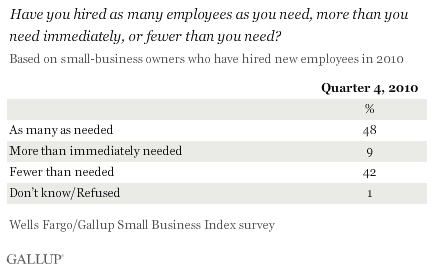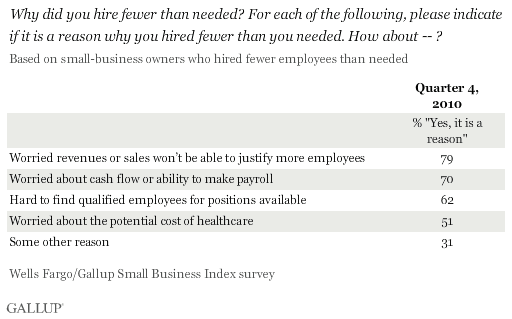PRINCETON, NJ -- Half of small-business owners (51%) who employ people other than themselves hired new workers in 2010, according to the Wells Fargo/Gallup Small Business Index survey. However, of these, 42% hired fewer new employees than they needed -- likely a major reason job growth was so anemic last year. Of course, an additional factor is that 48% of small businesses with more than one employee did not make any new hires in 2010.

The Wells Fargo/Gallup Small Business Index survey further reveals that the top reason so many of these small-business owners are hiring fewer employees than they need is that they are worried they won't have sales or revenues to justify more employees. This is followed by worries about their future cash flows and whether they will have money to make payroll. Third is their concern that they can't find employees who are qualified for the positions available. Finally, half of owners say they are worried about the potential cost of healthcare.

The survey, conducted Nov. 4-10, 2010, with 604 randomly sampled small-business owners nationwide, asked respondents who employ people other than themselves about their recent hiring activity and the reasons behind it. The major reason small businesses hired new employees in 2010 was to replace employees who left. The reason mentioned second most often was to support growth or expansion plans, followed by an increase in sales or revenue.

Implications
The hiring efforts of small-business owners in 2010 provide some insights into why generating job growth continues to be so difficult. The most important reason for today's anemic job growth among small businesses seems to be that many are hiring fewer employees than they need. They are doing so in part because they are worried about their future revenues and cash flows -- reasonable concerns, given the small-business operating environment of the past couple of years. Significantly, this is something that can turn around quickly if the economy continues to gain positive momentum, as seems to be the case in the most recent economic data, such as the improvement in the Chicago PMI report, stronger-than-expected auto sales, and the better-than-expected ISM non-manufacturing report that came out during the past week.
More troubling is the explanation of a large percentage of small-business owners that they can't find enough qualified employees for the jobs they have available. This reflects the way the U.S. economy is changing and adjusting to the new global marketplace of the past few years. It is also indicative of today's structural unemployment, in which many workers who have been out of work for a long time may no longer be able to be productive without retraining and additional education.
Of course, job creation is also a problem because some sectors of the U.S. economy -- such as housing and real estate -- are not recovering. Although the sample sizes are small, small-business owners who say they let workers go in 2010 suggest they did so because they felt the economy was getting worse and owing to decreases in their revenues or sales.
Small businesses are essential to the future of U.S. job growth. Reducing economic uncertainty and increasing small-business owners' confidence in their future revenues and cash flows is key to unleashing the hiring of the new employees these firms need. Some of this will happen naturally, as the private sector expands, but efforts by the federal government and the Federal Reserve to speed the process are a must if the real unemployment rate is going to fall to more traditional levels anytime soon.
Survey Methods
Results for the total dataset are based on telephone interviews with 604 small-business owners, conducted Nov. 4-10, 2010. For results based on the total sample of small-business owners, one can say with 95% confidence that the maximum margin of sampling error is ±4 percentage points.
For questions based on the 417 employers who employ people other than themselves in 2010, the maximum margin of error is ±5 percentage points.
For questions based on the 223 employers who have hired new employees in 2010, the maximum margin of error is ±7 percentage points. For questions based on the 98 employers who have hired fewer new employees than needed in 2010, the maximum margin of error is ±11 percentage points.
Sampling is done on a random-digit-dial basis using Dun & Bradstreet sampling of small businesses having $20 million or less of sales or revenues. The data are weighted to be representative of U.S. small businesses within this size range nationwide.
In addition to sampling error, question wording and practical difficulties in conducting surveys can introduce error or bias into the findings of public opinion polls.
For more details on Gallup's polling methodology, visit www.gallup.com.
